Mindful breathing exercises effectively reduce anxiety and enhance mental clarity. These techniques promote relaxation, improve emotional regulation, and can be integrated into daily life. Cultural contexts influence practices, while specific exercises offer unique benefits. Addressing common challenges can enhance the effectiveness of these methods for better stress management.
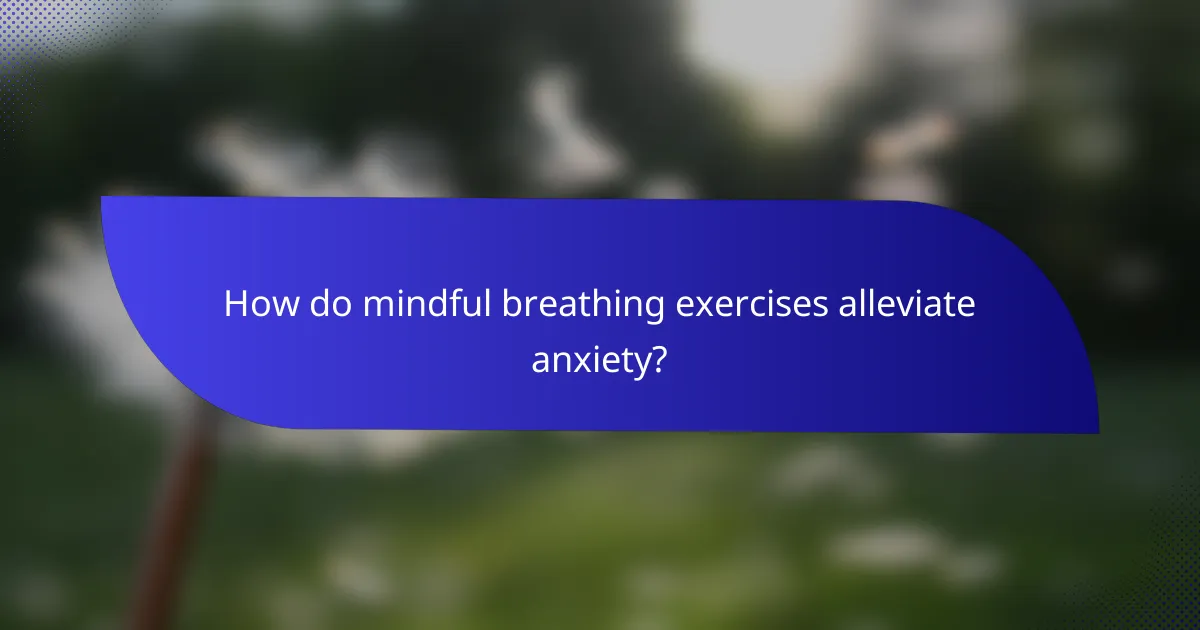
How do mindful breathing exercises alleviate anxiety?
Mindful breathing exercises effectively alleviate anxiety by promoting relaxation and enhancing mental clarity. These techniques focus on deep, intentional breaths that activate the body’s relaxation response. Research shows that mindful breathing can lower cortisol levels, the stress hormone, leading to reduced anxiety symptoms. Additionally, regular practice can improve emotional regulation and increase awareness of present-moment experiences, providing a unique attribute of resilience against stress. Engaging in these exercises for just a few minutes daily can yield significant benefits in managing anxiety.
What physiological changes occur during mindful breathing?
Mindful breathing induces several physiological changes that enhance relaxation and mental clarity. It reduces heart rate and lowers blood pressure, promoting a state of calm. Additionally, mindful breathing activates the parasympathetic nervous system, which counters stress responses. This practice increases oxygen flow to the brain, enhancing cognitive function and emotional regulation. By focusing on breath, individuals often experience a decrease in anxiety levels, leading to improved overall well-being.
Which breathing techniques are most effective for anxiety reduction?
Mindful breathing techniques such as diaphragmatic breathing and box breathing effectively reduce anxiety. These practices promote relaxation and enhance mental clarity by focusing attention on the breath.
Diaphragmatic breathing involves inhaling deeply through the nose, allowing the diaphragm to expand, then exhaling slowly through the mouth. This technique can lower heart rate and decrease stress levels.
Box breathing, or square breathing, consists of four equal parts: inhale for four counts, hold for four counts, exhale for four counts, and hold again for four counts. This method stabilizes breath and calms the nervous system.
Regular practice of these techniques can lead to significant improvements in anxiety management and overall well-being.
Why is consistency important in practicing mindful breathing?
Consistency in practicing mindful breathing is crucial for achieving anxiety reduction and mental clarity. Regular practice reinforces neural pathways, making it easier to enter a calm state during stressful moments. It cultivates a habit that enhances emotional regulation and focus. Research indicates that daily mindful breathing can significantly lower anxiety levels over time, promoting a sense of well-being. Additionally, consistency allows practitioners to deepen their awareness and improve their overall mindfulness skills, leading to long-lasting benefits.

What role does mindful breathing play in enhancing mental clarity?
Mindful breathing significantly enhances mental clarity by promoting focus and reducing anxiety. This practice encourages deep, intentional breaths, which activate the parasympathetic nervous system. As a result, stress levels decrease, allowing for improved cognitive function. Research indicates that just a few minutes of mindful breathing can lead to noticeable improvements in attention and clarity. Regular practice fosters a state of calm, making it easier to process information and make decisions effectively.
How can mindful breathing improve focus and concentration?
Mindful breathing significantly enhances focus and concentration by promoting relaxation and clarity. This practice reduces anxiety, allowing the mind to center on tasks. Engaging in mindful breathing exercises, such as deep diaphragmatic breathing, can improve cognitive functions. Research indicates that consistent practice leads to better attention spans and memory retention. Regular sessions, even for a few minutes, can yield substantial benefits in mental clarity and productivity.
Which mindful breathing exercises are best for boosting cognitive performance?
Mindful breathing exercises that enhance cognitive performance include deep diaphragmatic breathing, box breathing, and 4-7-8 breathing. These techniques promote relaxation, improve focus, and boost mental clarity.
Deep diaphragmatic breathing involves inhaling deeply through the nose, allowing the abdomen to expand, and exhaling slowly through the mouth. This practice increases oxygen flow to the brain, enhancing cognitive function.
Box breathing consists of inhaling for four counts, holding for four counts, exhaling for four counts, and holding again for four counts. This method stabilizes heart rate and reduces anxiety, leading to improved concentration.
4-7-8 breathing entails inhaling for four seconds, holding for seven seconds, and exhaling for eight seconds. This technique calms the nervous system, promoting clarity and cognitive efficiency.
Incorporating these exercises into daily routines can significantly enhance cognitive performance and mental clarity.
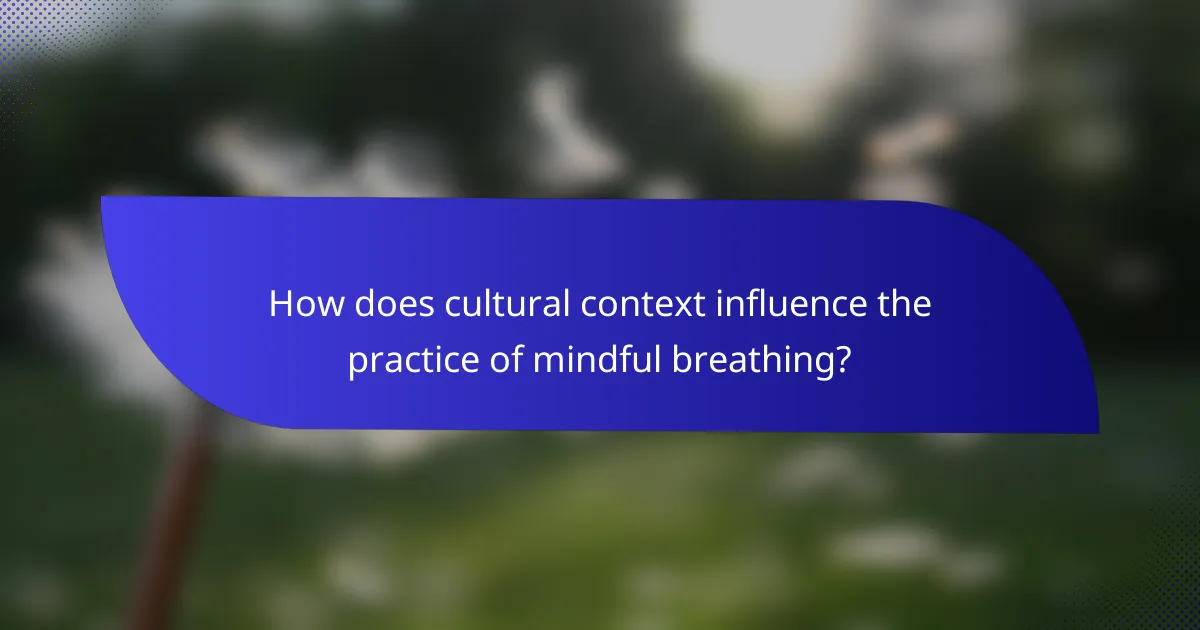
How does cultural context influence the practice of mindful breathing?
Cultural context significantly shapes the practice of mindful breathing. Different cultures integrate unique beliefs and practices that influence how individuals approach these exercises. For instance, Eastern traditions often emphasize spiritual connections, while Western practices may focus on psychological benefits. Cultural narratives around stress and mental health also dictate the acceptance and application of mindful breathing techniques. As a result, variations in practice can lead to diverse outcomes in anxiety reduction and clarity, reflecting the values and priorities of each culture. Understanding these influences can enhance the effectiveness of mindful breathing across different contexts.
What are the traditional roots of breathing exercises in different cultures?
Mindful breathing exercises have roots in various cultures, often linked to spiritual and health practices. In India, pranayama is a key aspect of yoga, focusing on breath control to enhance mental clarity and reduce anxiety. Chinese culture emphasizes qigong, where breath is synchronized with movement to promote energy flow and relaxation. Native American traditions incorporate breathwork in rituals to foster connection with nature and spiritual grounding. In Western practices, mindfulness meditation integrates breathing techniques to cultivate awareness and emotional balance. Each tradition highlights the transformative power of breath in achieving mental well-being.
How do modern adaptations of mindful breathing vary across regions?
Modern adaptations of mindful breathing exercises vary significantly across regions, reflecting cultural practices and philosophies. In Eastern traditions, such as yoga and tai chi, breathing techniques emphasize energy flow and spiritual connection. Western adaptations often focus on stress reduction and cognitive clarity, incorporating scientific research on mental health.
For instance, in Japan, the practice of “Shikantaza” promotes awareness through breath, fostering a deep state of presence. In contrast, American mindfulness practices frequently utilize structured programs like Mindfulness-Based Stress Reduction (MBSR), which integrates breathing with cognitive behavioral techniques.
These diverse approaches highlight unique attributes of mindful breathing, such as community engagement in group sessions or solitary practices that emphasize personal introspection. Rare adaptations may include specific cultural rituals, such as the use of chanting or visualization alongside breathing to enhance emotional healing.
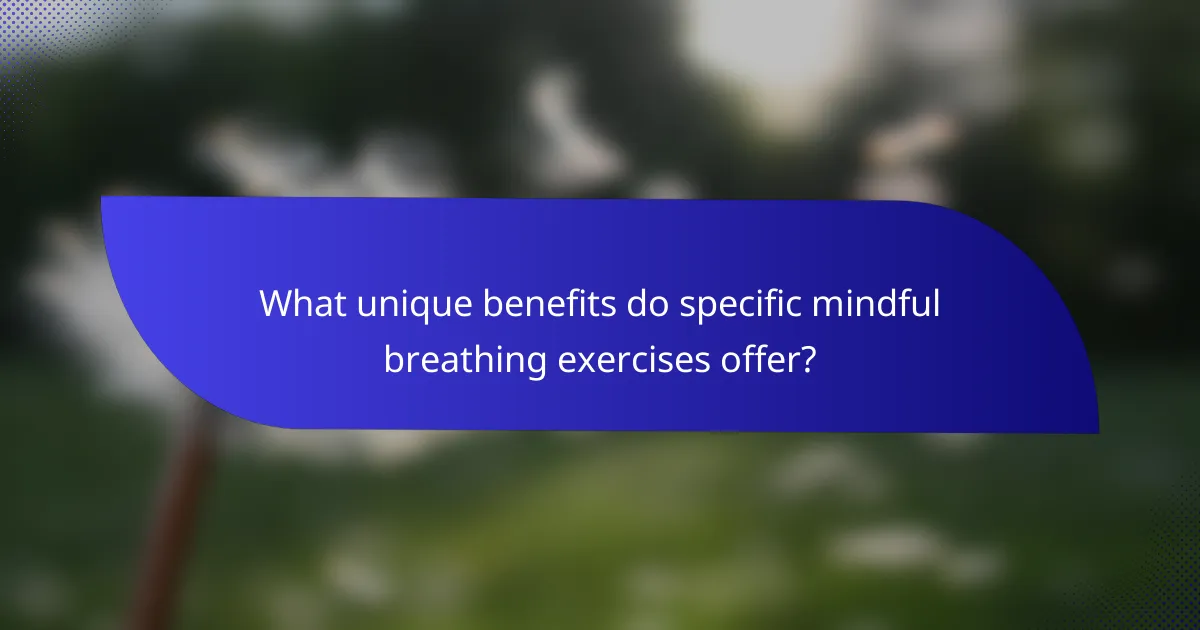
What unique benefits do specific mindful breathing exercises offer?
Specific mindful breathing exercises offer unique benefits such as enhanced emotional regulation, increased mental clarity, and reduced anxiety levels. Techniques like diaphragmatic breathing can lower cortisol levels, promoting relaxation. Box breathing fosters focus by engaging the mind in structured patterns. Alternate nostril breathing balances the nervous system, enhancing overall well-being. These practices uniquely empower individuals to manage stress effectively, leading to improved emotional resilience.
How does the 4-7-8 technique differ from other methods?
The 4-7-8 technique focuses on a specific breathing pattern that promotes relaxation, differing from other methods that may not emphasize rhythm. This technique involves inhaling for four seconds, holding for seven seconds, and exhaling for eight seconds. Other mindful breathing exercises may vary in duration or focus, such as diaphragmatic breathing, which emphasizes deep belly breaths without a structured rhythm. The unique attribute of the 4-7-8 technique is its precise timing, designed to activate the parasympathetic nervous system effectively. As a result, practitioners often experience a quicker reduction in anxiety and enhanced mental clarity compared to more generalized breathing exercises.
What are the advantages of using guided breathing sessions?
Guided breathing sessions offer significant advantages for anxiety reduction and mental clarity. They promote relaxation, enhance focus, and help regulate emotions. Regular practice can lead to lower stress levels, improved mindfulness, and increased self-awareness. Additionally, these sessions can foster a sense of control over one’s thoughts and feelings, empowering individuals to manage anxiety more effectively.
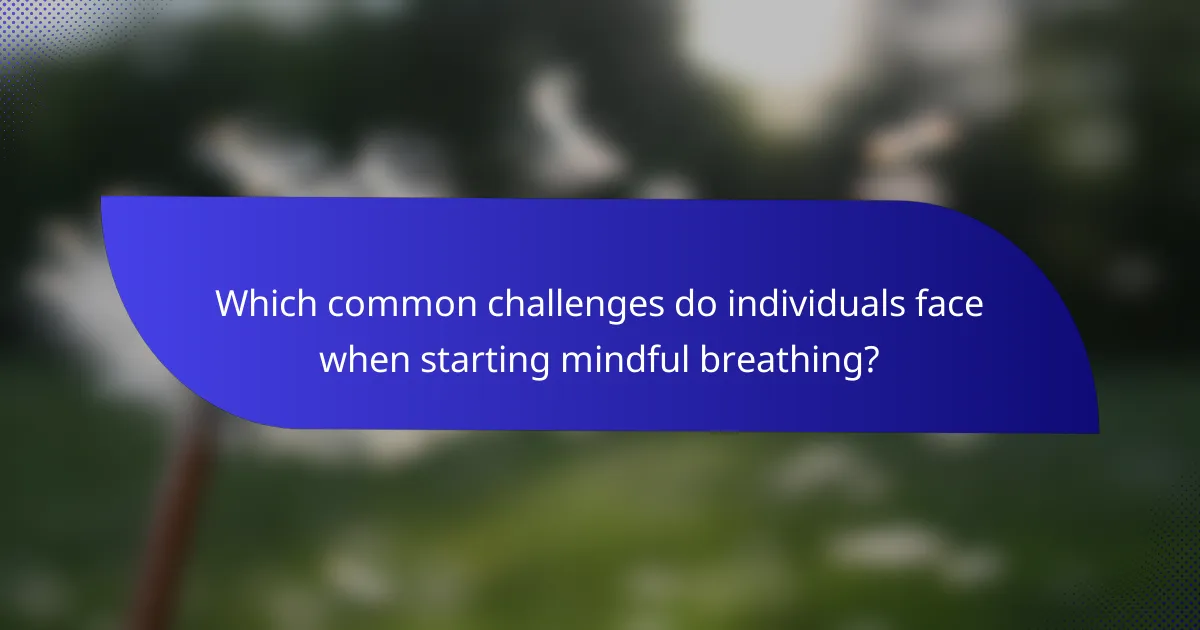
Which common challenges do individuals face when starting mindful breathing?
Individuals often face challenges such as difficulty focusing, physical discomfort, and impatience when starting mindful breathing. These obstacles can hinder the effectiveness of the practice. For instance, a wandering mind may distract from the breathing process, while discomfort can arise from prolonged sitting. Additionally, many people struggle with the expectation of immediate results, leading to frustration. Addressing these challenges with gradual practice and self-compassion can enhance the experience and benefits of mindful breathing exercises for anxiety reduction and clarity.
What misconceptions about mindful breathing should be addressed?
Many misconceptions about mindful breathing include the belief that it requires extensive practice or is solely for relaxation. In reality, mindful breathing can be easily integrated into daily life and serves multiple purposes beyond relaxation, such as enhancing focus and emotional regulation. Some people think it is only effective for stress relief, but studies show it also improves cognitive clarity and overall mental well-being. Another common myth is that mindful breathing is only beneficial for those with anxiety; however, it can enhance mindfulness and presence for anyone, regardless of their mental state.
How can beginners overcome barriers to effective practice?
Beginners can overcome barriers to effective practice by incorporating mindful breathing exercises into their routine. These exercises enhance focus and reduce anxiety, creating a conducive environment for practice.
Start with simple techniques, such as deep belly breathing, to cultivate awareness and presence. Consistency is key; set aside a few minutes daily to practice. Gradually increase the duration as comfort grows. Join a group or use guided sessions to stay motivated and accountable.
Tracking progress can also help; noting feelings before and after practice can highlight improvements. Remember that patience is essential; mastery comes with time and dedication.
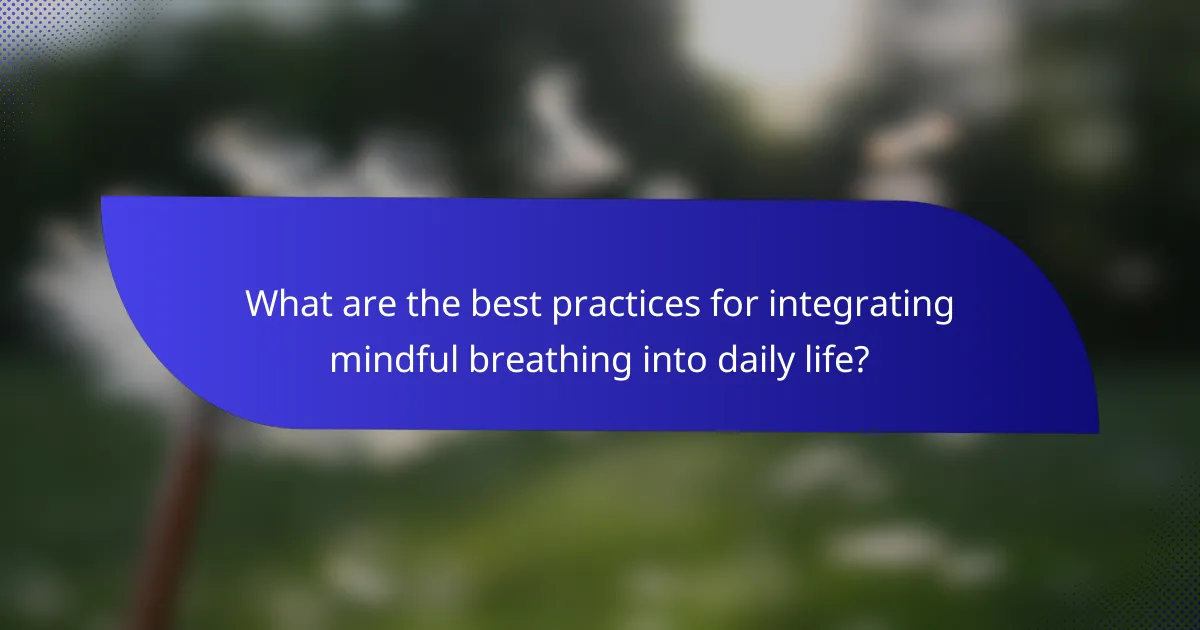
What are the best practices for integrating mindful breathing into daily life?
Integrating mindful breathing into daily life enhances relaxation and mental clarity. Start by dedicating a few minutes each day to practice deep, intentional breaths.
1. Set a specific time each day for mindful breathing.
2. Find a quiet space where you feel comfortable.
3. Close your eyes and focus on your breath, inhaling deeply through your nose.
4. Exhale slowly through your mouth, releasing tension.
5. Repeat this for five to ten minutes, gradually increasing the duration.
6. Incorporate mindful breathing during stressful moments throughout the day.
These practices cultivate a sense of calm and improve focus, making them valuable tools for anxiety reduction.
How can mindful breathing be combined with other wellness practices?
Mindful breathing can enhance various wellness practices, promoting overall well-being. Integrating mindful breathing with yoga can deepen relaxation and focus. When combined with meditation, it enhances clarity and emotional regulation. Pairing it with physical exercise improves stress relief and mindfulness during workouts. Additionally, using mindful breathing in daily routines fosters a consistent state of calm and awareness.
What expert tips can enhance the effectiveness of mindful breathing exercises?
Incorporating expert tips can significantly enhance the effectiveness of mindful breathing exercises. Focus on consistent practice to build familiarity and comfort with the technique.
1. Establish a routine: Set specific times for practice to create a habit.
2. Use guided sessions: Follow audio or video instructions to maintain focus.
3. Limit distractions: Choose a quiet space to enhance concentration.
4. Experiment with techniques: Explore different breathing patterns to find what works best.
5. Combine with visualization: Pair breathing exercises with calming imagery for deeper relaxation.
6. Track progress: Note improvements in anxiety levels and clarity to stay motivated.
Which common mistakes should be avoided when practicing mindful breathing?
Common mistakes to avoid when practicing mindful breathing include rushing the process, losing focus, and neglecting posture. These errors can hinder the effectiveness of exercises aimed at anxiety reduction and clarity. Rushing may lead to shallow breathing, while losing focus diminishes mindfulness. Poor posture can restrict airflow, impacting overall benefits. To maximize results, take your time, maintain concentration, and ensure comfortable alignment.